This post may contain affiliate links. Please read my disclosure.
Yamagobo is a Japanese style pickle marinated in a combination of salt, sugar, rice vinegar and ginger. It is typically orange in color and often mistaken for carrots in sushi rolls!
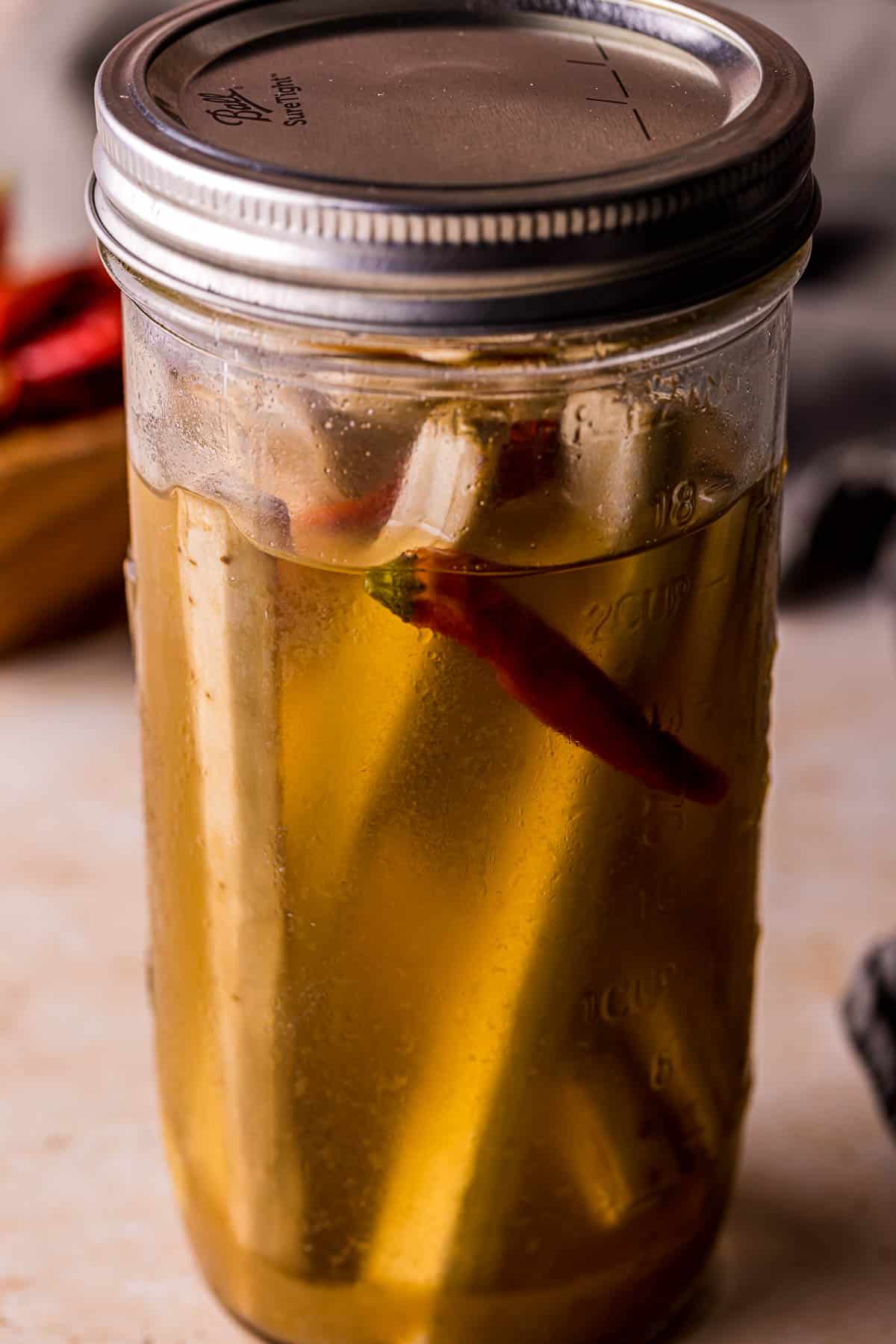
Yes, what you thought was carrots in those sushi rolls is actually pickled burdock root colored with carrot powder or food coloring.
It's sweet, salty, tangy and just delicious - I can think of all sorts of things to have this on (maybe even this banh mi).
This yamagobo recipe works great not only for making your own sushi rolls, but also served with Japanese dishes like these:
- Serve it as a garnish for this instant pot sushi rice
- Brighten up your kakuni
- Chop it and serve with this pork belly yakisoba
- Serve it in these temaki sushi hand rolls
If you are a fan of the tart, tangy, sweetness of anything pickled, you will fall in love with this easy pickle recipe! And it is addictive!
Jump to:
What is Yamagobo?
Yamagobo is a type of Japanese pickle made from the root of the burdock plant. It is a popular ingredient in Japanese cuisine, particularly in sushi rolls (many times in maki sushi rolls) and bento boxes.
It looks a lot like carrots, but is not! Most likely, that orange vegetable in your sushi roll is yamagobo, NOT carrot.
Want to Save This Recipe?
Enter your email & I'll send it to your inbox. Plus, get great new recipes from me every week!
By submitting this form, you consent to receive emails from Went Here 8 This.
Why This Recipe Works
- It's super simple to make, taking less than 20 minutes to put together.
- It lasts in the fridge for up to a month, so there is plenty of time to use it.
- No canning is required - this is a simple refrigerator pickle.
- Not only is it perfect for making your own sushi rolls, but it is awesome served with rich dishes to lighten them up.
- The sweet, tangy, salty crunch is so ultra satisfying, especially if you're a pickle lover.
Ingredients
The full list of ingredients and amounts is included in the recipe card at the bottom of the post.
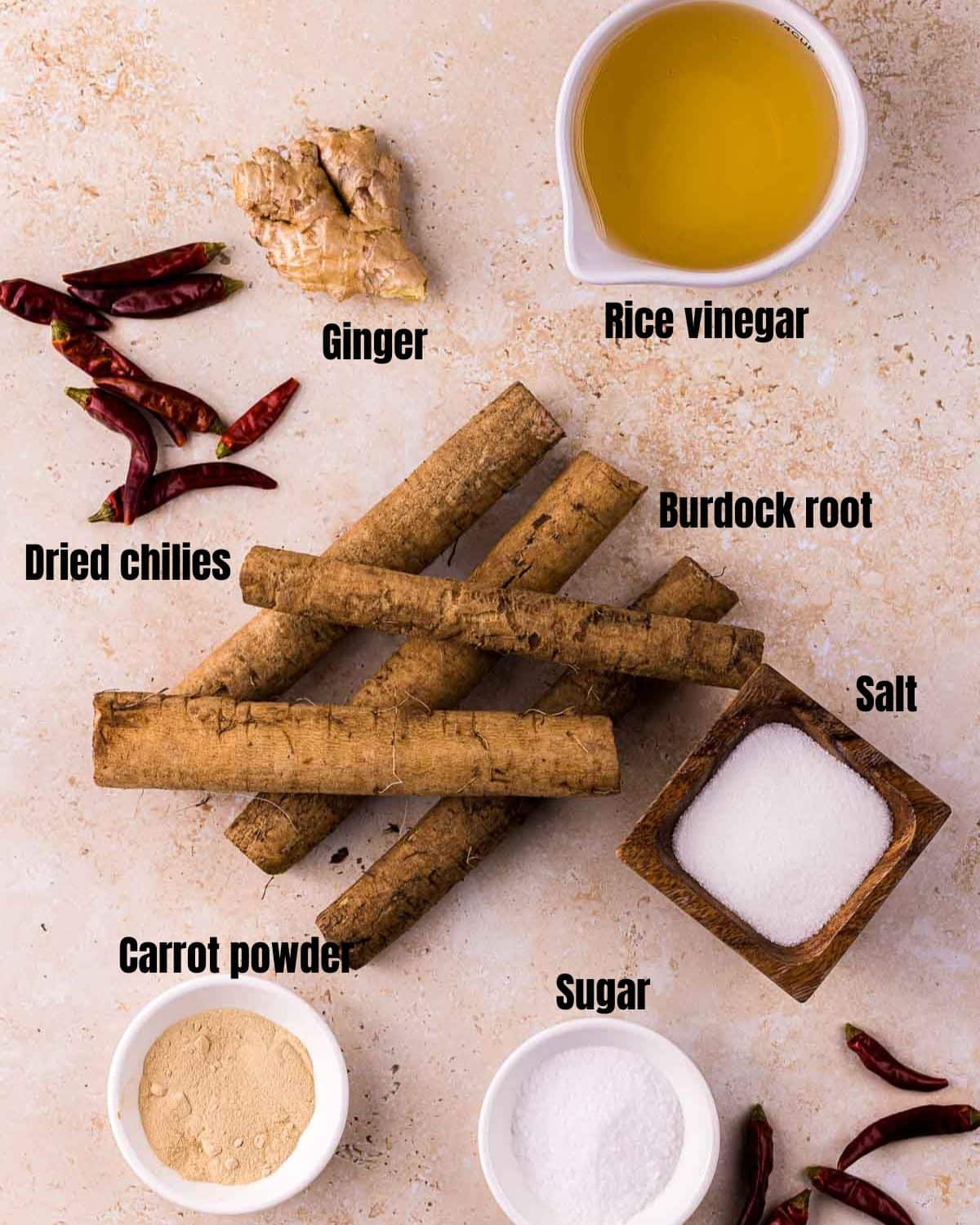
Burdock root (also called gobo) can be found at most Asian markets. It looks like a very long, brown fuzzy carrot. The interior is white colored.
Rice vinegar is the vinegar most often used as has the perfect amount of tang and sweetness for the pickle.
We also use a couple slices of fresh ginger (no need to remove the skin - just be sure to wash it) and an option for 1-2 dried Thai chilies if you want to add some spice.
Traditional recipes use carrot powder to get the orange color, but you can also use food coloring. Or, you can just let it keep it's natural color. We used a lighter hued carrot powder here, so don't get much color on ours.
Step By Step Instructions
Combine the 2 cups of water and ½ cup rice vinegar in a bowl.
Use a vegetable peeler to peel the outside skin from the burdock root, revealing the white flesh.
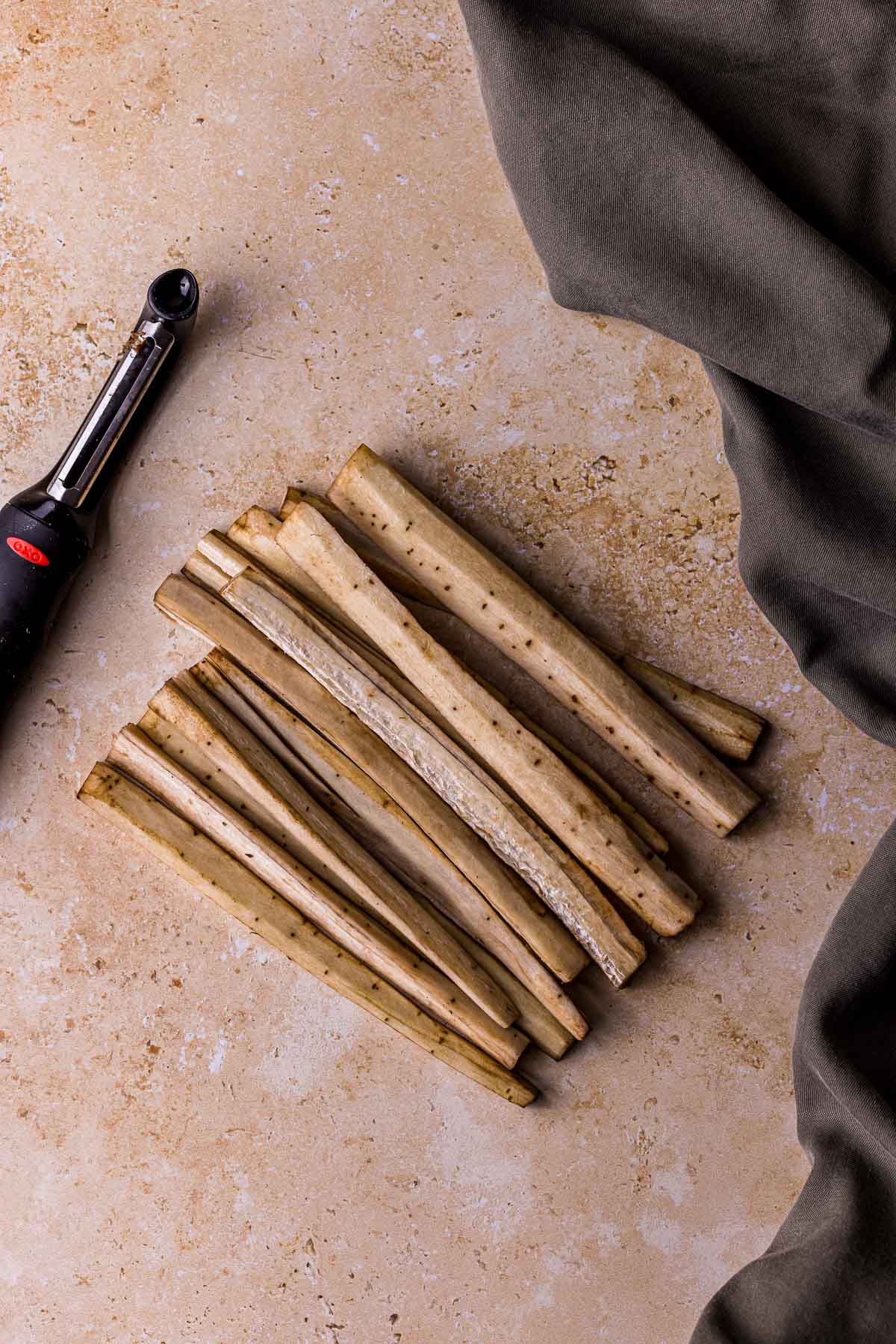
Cut the root into 4-6 inch matchstick pieces (depending on the size of the jar you will use for pickling).
Watch this video on how to cut gobo - I typically peel it with a vegetable peeler which is slightly different than tis vide shows.
Place the matchsticks in the bowl with water and vinegar. Set aside.
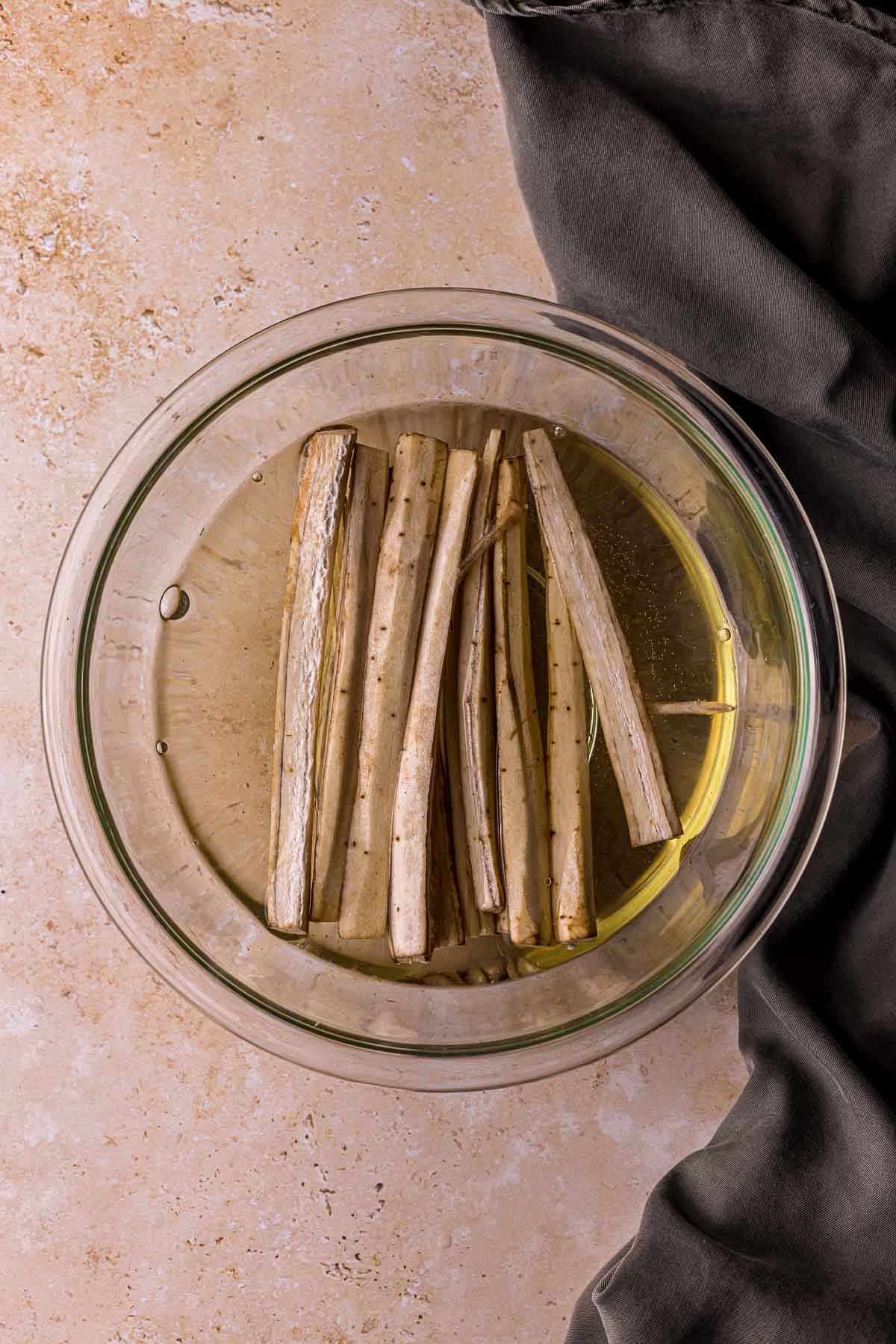
Combine the remaining vinegar and water, sugar, salt, ginger, chilies and carrot powder in a small saucepan and heat until it simmers.
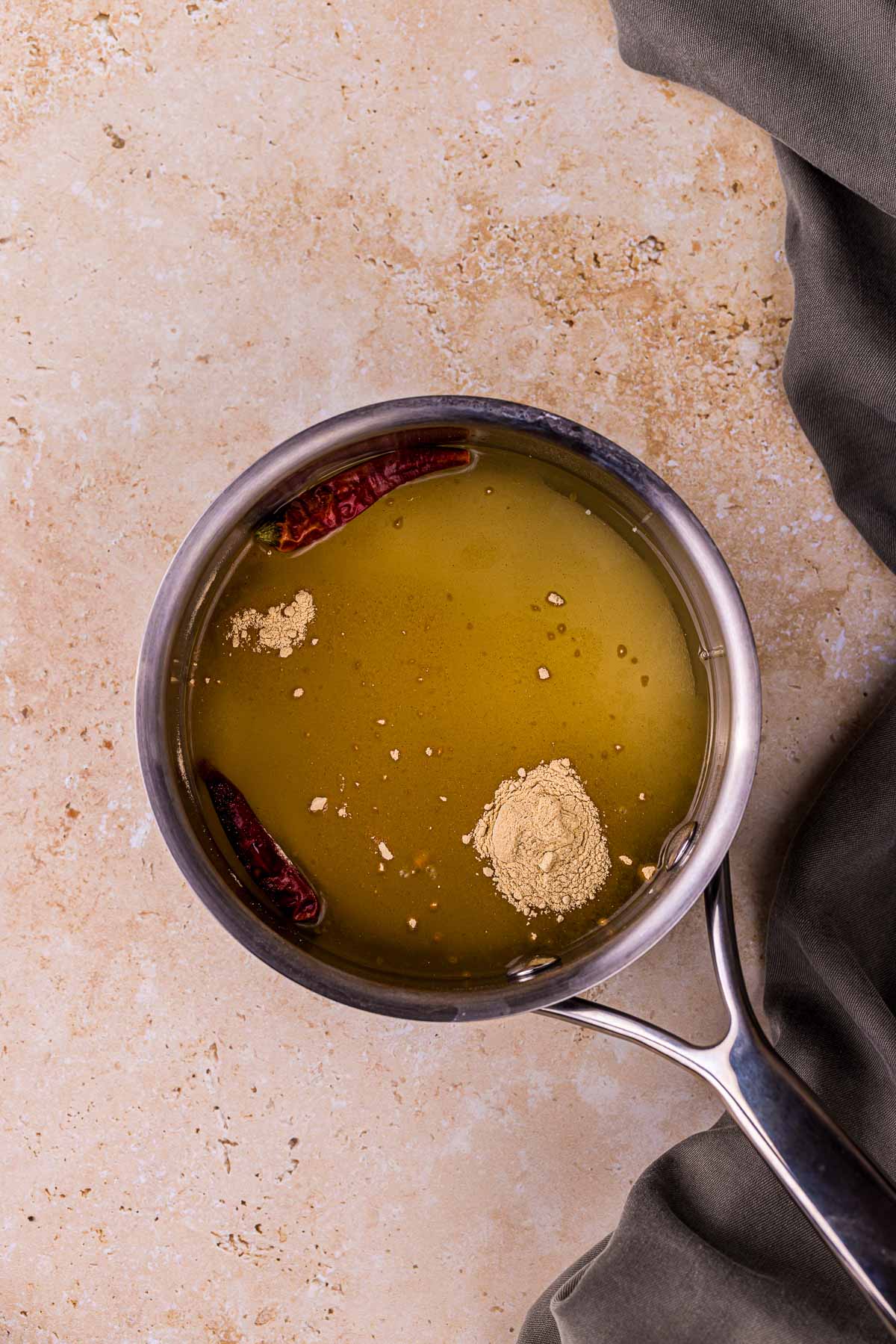
Remove from heat and let it cool to room temperature.
Place the burdock root matchsticks in an 2-8 or 1-16 ounce canning jar(s) with a wide mouth.
Pour the cooled picking liquid over the top and seal the lids. Let it sit in the fridge for 3-5 days before serving for the best results.
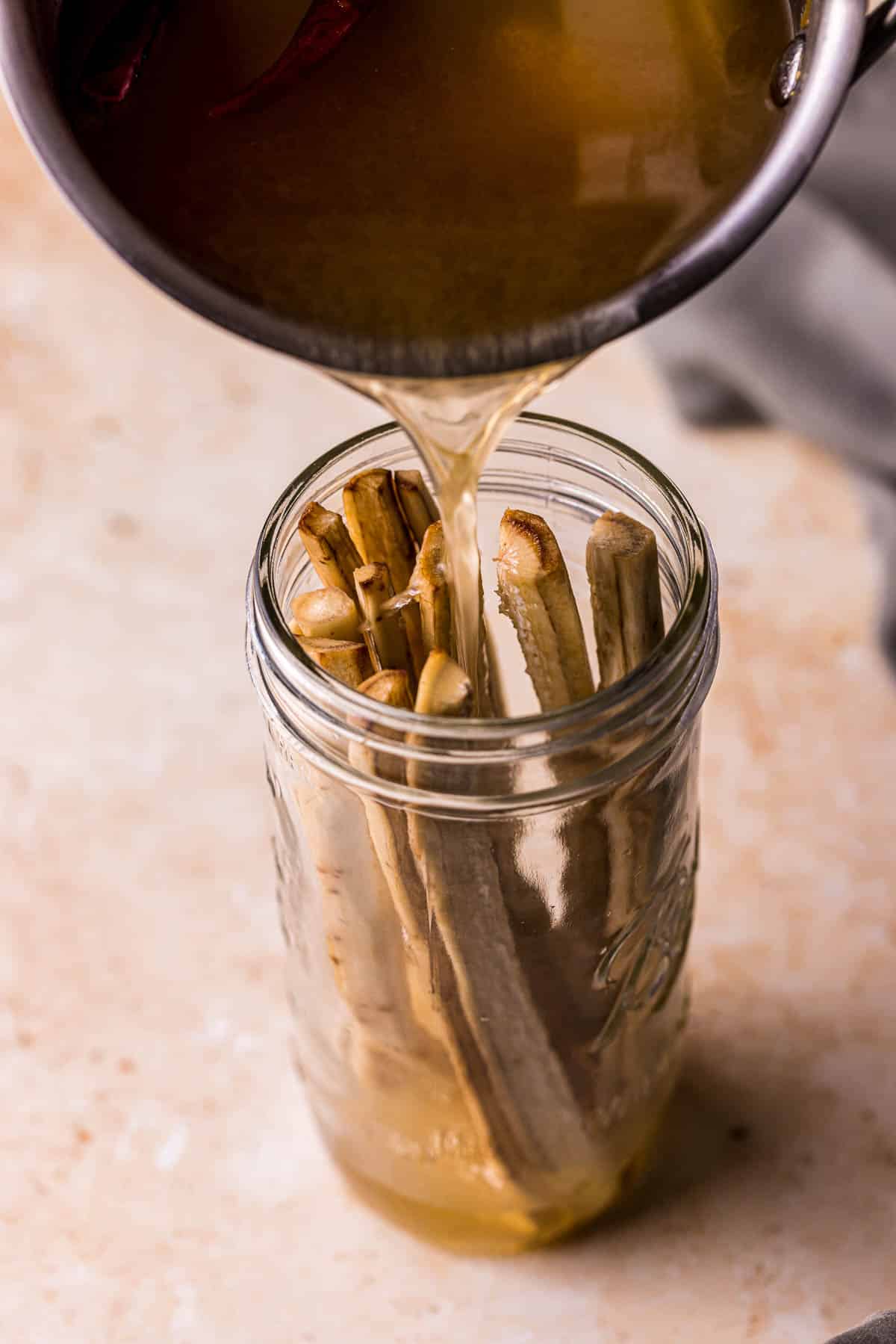
Expert Tips
- Soaking the matchsticks in the vinegar and water after peeling helps keep them from turning brown and also takes away a little of the astringent taste.
- You can omit the carrot powder or food coloring as it won't have an impact on the taste of the final product - they are only used for color.
- Let it sit for at least 3-5 days to allow the flavors to penetrate the burdock root.
- Cut the matchsticks to fit whatever size jar(s) you are using. I used 2-8 ounce jars so cut them short.
- You can halve or double the recipe (or triple, etc.).
- The Thai chilies are completely optional and not traditional. You can omit if you prefer.
- For a more gingery flavor, add 2-3 additional slices of ginger. You can also add 1-2 slices of garlic if you'd like that flavor.

Serving Options
- Like we discussed, yamagobo is great used in sushi rolls if you're ready to break that bamboo mat out!
- Dice it up and serve it on salads
- Serve it with richer cuts of meat like this sous vide pork belly, sous vide salmon, pork belly tacos or ground pork tacos
- Serve on a charcuterie board to accompany some sharp cheeses.
- Amazing in rice bowls like this Korean bibimbap.
- Perfect to lighten up any ramen dish: Korean ramen, birria ramen, tantan ramen, miso ramen.
- It's honestly great served with anything - once you taste it you'll see how it can liven up a great many dishes!
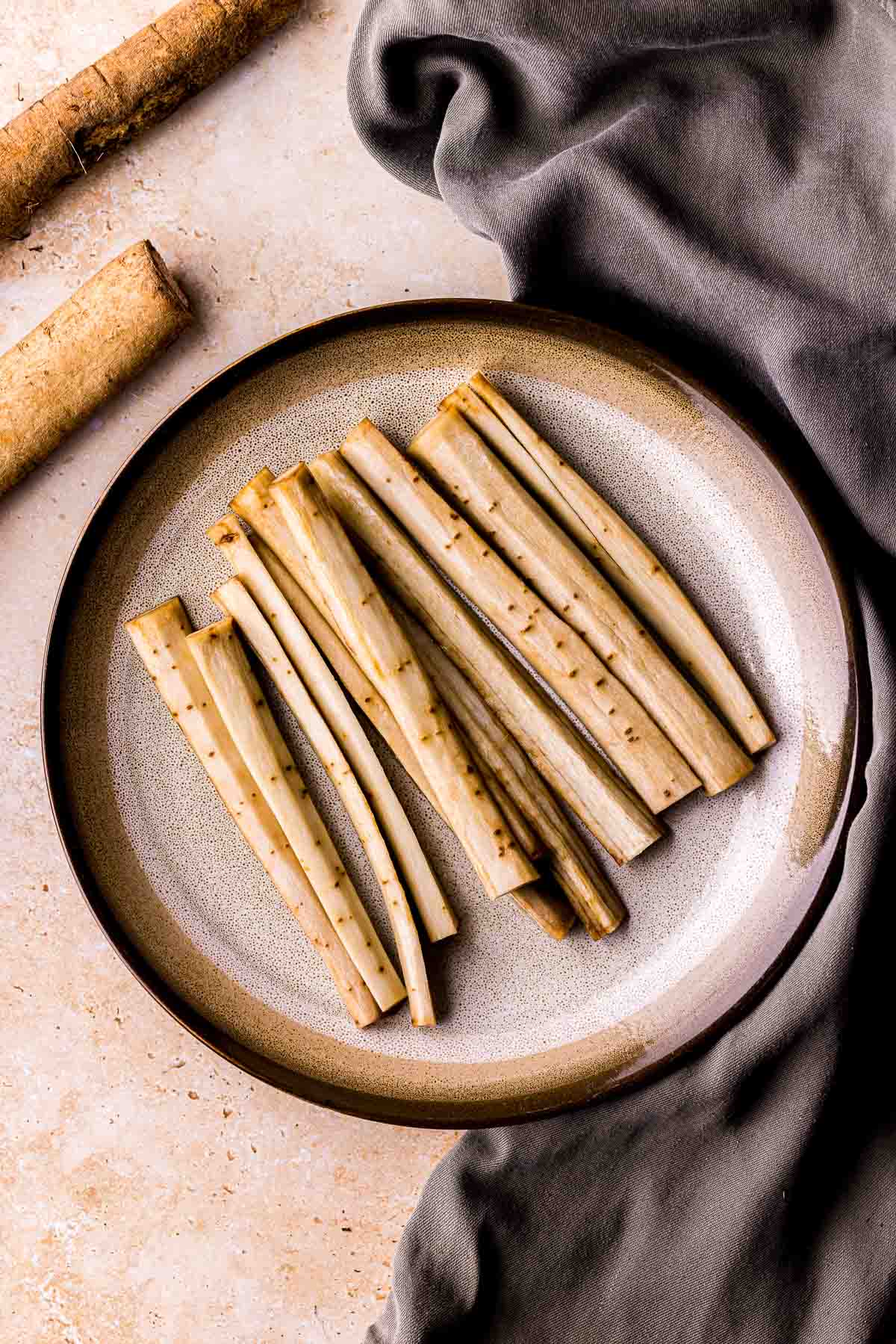
Frequently Asked Questions
Yamagobo is slightly sweet, tangy and just a touch salty. It is great eaten as a snack, used in sushi rolls, or as an accompaniment to a richer dish like pork belly or ramen noodles.
Yamagobo is orange colored pickled burdock root (gobo) typically used t make maki sushi rolls. It has a sweet, salty, tangy flavor and is very easy to make at home.
Yamagobo is a Japanese style pickle made from burdock root (gobo), salt, rice vinegar sugar, water and ginger. It is often used in maki sushi rolls and identified by it's orange color.
Yamagobo is vegan and is also gluten free (as long as your vinegar does not contain gluten).

Storage Instructions
Yamagobo can be store in the fridge for up to a month. It is ready to eat after 3-5 days. I do not recommend freezing it.
If you love this recipe, please leave a star rating and a comment below and let us know your favorite thing about it. We'd also love to connect on Instagram! Follow us at @went_here_8_this for awesome recipes and all sorts of fun food stuff 🙂
Recipe
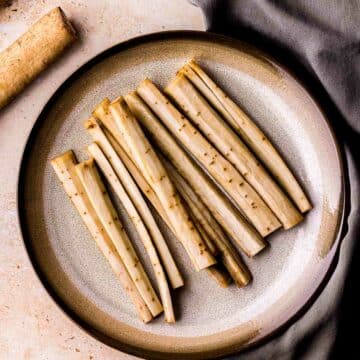
Yamagobo (Japanese Pickled Burdock Root)
Ingredients
- ½ pound fresh burdock root
- ¾ cup rice vinegar plus ½ cup
- ¾ cup sugar
- ¾ cup water plus 2 cups
- 1 ½ tablespoons salt
- 2 slices fresh ginger
- 1-2 dried Thai chilies optional
- 1 teaspoon carrot powder optional for coloring
Instructions
- Combine the 2 cups of water and ½ cup rice vinegar in a bowl.
- Use a vegetable peeler to peel the outside skin from the burdock root, revealing the white flesh.
- Cut the root into 4-6 inch matchstick pieces (depending on the size of the jar you will use for pickling).
- Place the matchsticks in the bowl with water and vinegar. Set aside.
- Combine the remaining vinegar and water, sugar, salt, ginger, chilies and carrot powder in a small saucepan and heat until it simmers.
- Remove from heat and let it cool to room temperature.
- Place the burdock root matchsticks in 2-8 or 1-16 ounce canning jar(s) with a wide mouth.
- Pour the cooled picking liquid over the top and seal the lids. Let it sit in the fridge for 3-5 days for the best results.
Expert Tips:
- Soaking the matchsticks in the vinegar and water after peeling helps keep them from turning brown and also takes away a little of the astringent taste.
- You can omit the carrot powder or food coloring as it won't have an impact on the taste of the final product - they are only used for color.
- Let it sit for at least 3-5 days to allow the flavors to penetrate the burdock root.
- Cut the matchsticks to fit whatever size jar(s) you are using. I used 2-8 ounce jars so cut them short.
- You can halve or double the recipe (or triple, etc.).
- The Thai chilies are completely optional and not traditional. You can omit if you prefer.
- For a more gingery flavor, add 2-3 additional slices of ginger. You can also add 1-2 slices of garlic if you'd like that flavor.
Nutrition
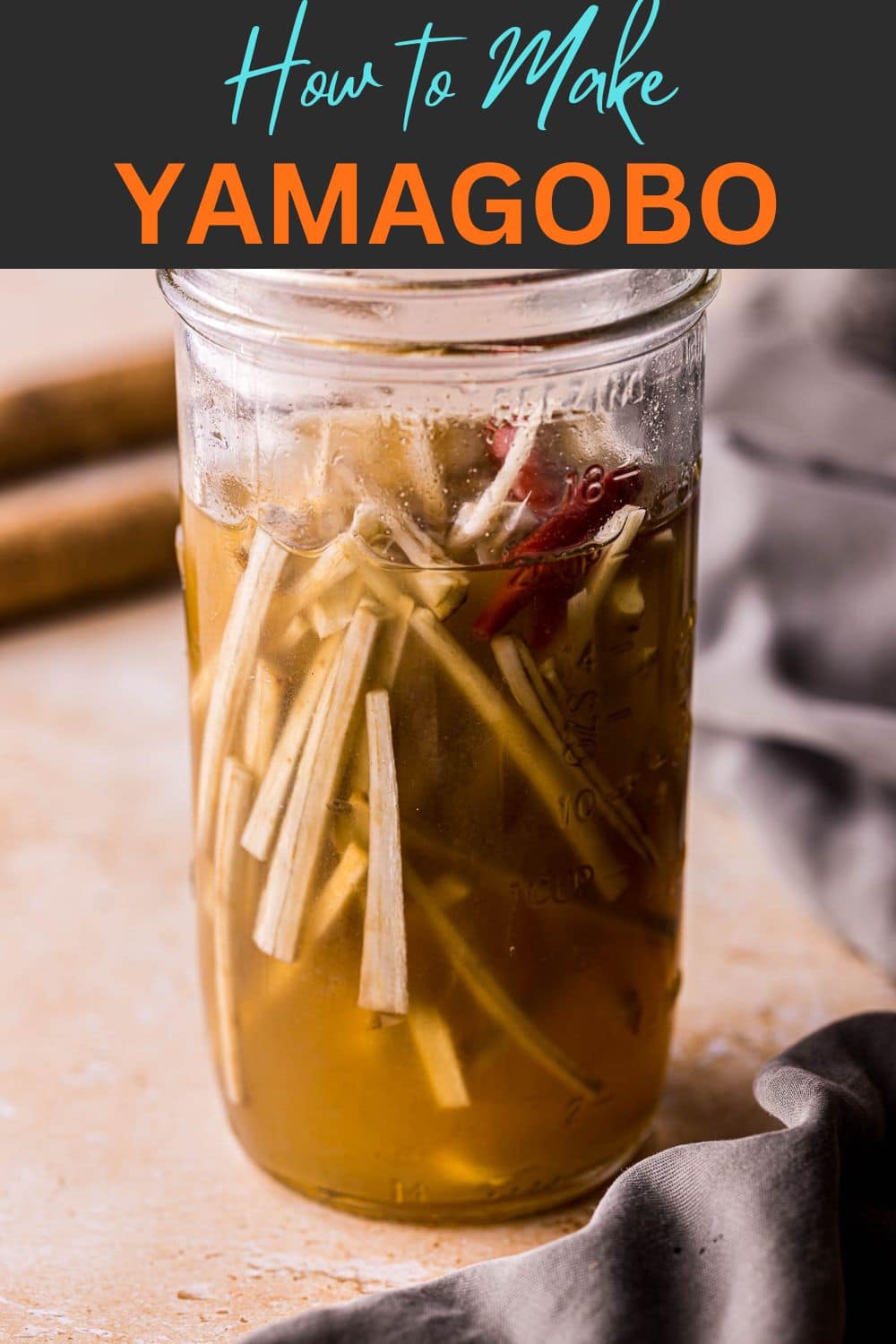

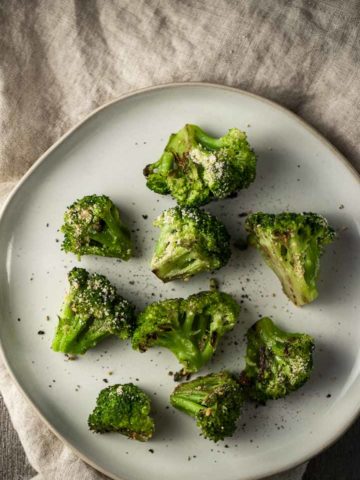
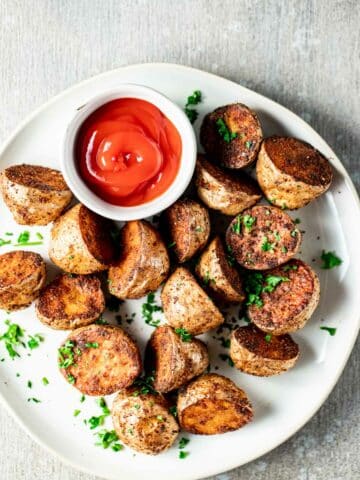
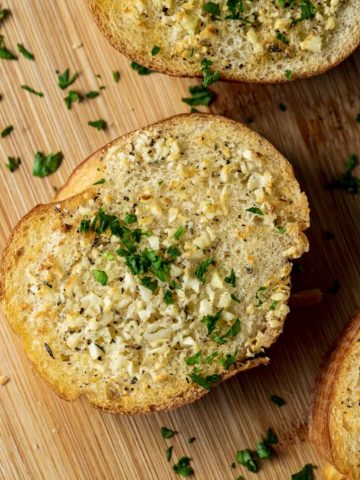
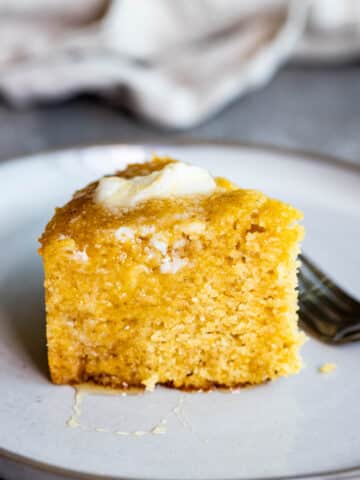
Gabby says
Can I omit the sugar? Would it change the flavor?
Danielle says
It will change the flavor quite a bit. Typically when pickling you need the sugar to balance out the flavors. You can definitely try, but it will likely take on a more bitter, sour flavor, which is fine if that's your thing!
heather says
I was kind of expecting this to come out more orange than it did, but the taste was so good!! I chopped it up and used it on top of rice with some fish. SO yummy!
Danielle says
SO glad to hear it!